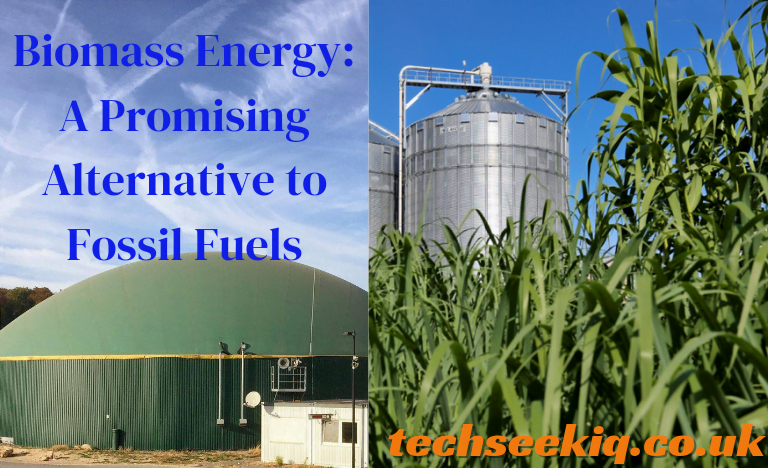
A Promising Alternative to Fossil Fuels is Biomass renewable energy source, derived from organic materials such as plants and animal waste, which is gaining attention as a sustainable alternative to fossil fuels.
This renewable energy source offers several advantages, including its widespread availability, carbon neutrality, and potential to reduce the over reliance on fossil fuels. However, it also has its drawbacks and controversies, such as concerns about its efficiency, environmental impact, and sustainability.
The article is intended for a general audience interested in learning about alternative energy sources, including students, energy professionals, and the public.
Biomass
Biomass refers to organic material derived from plants and animals. It is a renewable energy source that contains stored chemical energy from the sun, produced by plants through photosynthesis. Biomass can be burned directly for heat or converted to liquid and gaseous fuels through various methods. It includes a wide range of materials, such as wood, agricultural residues, food crops, grassy and woody plants, algae, and organic components of municipal and industrial waste.
Biomass energy
Biomass energy is the energy derived from biomass. It can be harnessed to produce heat, electricity, or fuels, and can be used for various applications, including heating, electricity generation, and transportation fuel. Biomass energy is a versatile renewable energy source that can be converted into liquid transportation fuels, providing an array of benefits, including the potential to reduce greenhouse gas emissions.
Types of biomass

Biomass is a renewable energy source derived from organic materials such as wood, agricultural residues, and waste. It can be classified into natural biomass, residual biomass, and biomass produced by energy crops.
- Natural biomass
- Residual biomass
This includes natural biomass, which is produced in nature without human intervention, and residual biomass, which is organic waste produced by human activity. Biomass can be used for various purposes, such as fuels, power production, and products that would otherwise be made from fossil fuels.
It can be converted into electric power through methods such as direct combustion, gasification, pyrolysis, and anaerobic digestion. The methods to produce energy from biomass are grouped into two main categories:
a. Thermochemical methods
b. Biochemical methods
Thermochemical methods, which transform biomass through heat, and biochemical methods, which involve the use of microorganisms to break down biomass. Thermochemical methods include burning, gasification, and pyrolysis, while biochemical methods include anaerobic digestion and fermentation.

Advantages of Biomass Energy
- Renewable and Widely Available: Biomass is a renewable energy source derived from organic materials, such as wood, agricultural residues, and waste, which are constantly replenished by natural processes.
- Carbon Neutral: Biomass fuels only release the same amount of carbon into the atmosphere as was absorbed by plants during photosynthesis, making it a carbon-neutral energy source.
- Reduces Over reliance on Fossil Fuels: Biomass energy helps reduce the over reliance on finite fossil fuel resources, contributing to energy diversification and security.
Disadvantages of Biomass Energy
- Efficiency: Biomass energy is not as efficient as fossil fuels, and its production and conversion processes can be energy-intensive.
- Environmental Impact: There are concerns about the environmental impact of biomass energy, including deforestation, air pollution, and the release of greenhouse gases.
- Sustainability: The sustainability of biomass energy has been questioned, particularly in the context of its carbon neutrality and environmental impact.
What are the policies and regulations around biomass energy production?

Policies and regulations around biomass energy production are designed to ensure its sustainable and efficient use. In the UK, biomass use is expected to be prioritized according to principles outlined in the Biomass Policy Statement, with a focus on sustainable aviation fuel and hydrogen production.
The government has also published a Biomass Strategy, emphasizing the role of sustainable biomass in reaching net-zero and detailing steps to strengthen biomass sustainability. Additionally, there are specific regulations for biomass fuel, such as the requirement for wood pellets to meet quality standards and sustainability criteria.
The European Union has also established rules on sustainable biomass production and use to optimize greenhouse gas savings and maintain ecosystem balance. These regulations cover various aspects, including fuel quality, sustainability reporting, and environmental permitting.
It is important for stakeholders in the biomass energy sector to understand and comply with these regulations to ensure the sustainable and efficient use of biomass resources.
What are the consequences of not meeting the sustainability criteria for biomass energy production?

The sustainability criteria for biomass energy production include land criteria, greenhouse gas criteria, and sustainability reporting.
The land criteria focus on the land from which the biomass is sourced, while the greenhouse gas criteria account for the lifetime greenhouse gas emissions of the biomass. The sustainability reporting requirements cover fuel quality, sustainability reporting, and environmental permitting.
Failure to meet these criteria can result in non-sustainable biomass production, negative impacts on the environment, and the loss of eligibility for support under renewable energy schemes.
It is important for stakeholders in the biomass energy sector to understand and comply with these regulations to ensure the sustainable and efficient use of biomass resources.
How is biomass converted into energy?

Biomass can be converted into energy through various processes, including direct combustion, thermochemical conversion, and biochemical/biological conversion.
The most common method is direct combustion, where biomass is burned to produce heat, which can be used for heating buildings, providing industrial process heat, and generating electricity in steam turbines.
Thermochemical conversion processes, such as pyrolysis and gasification, involve heating the biomass feed stock to produce solid, gaseous, and liquid fuels.
Biochemical/biological conversion utilizes enzymes, bacteria, or other microbes to break down biomass into liquids and gaseous feed stocks, and it includes processes like fermentation and anaerobic digestion.
These various conversion methods make biomass a versatile renewable energy source that can be used for heating, electricity generation, and as a transportation fuel.